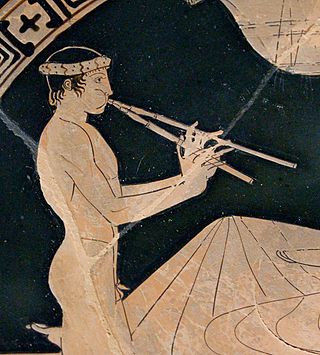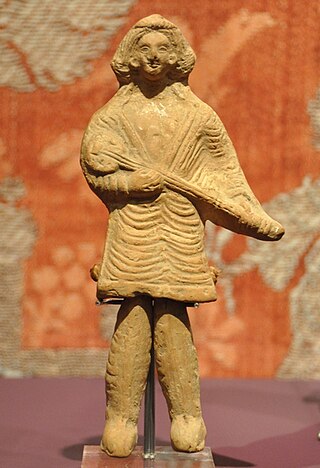Related Research Articles

An ode is a type of lyric poetry. Odes are elaborately structured poems praising or glorifying an event or individual, describing nature intellectually as well as emotionally. A classic ode is structured in three major parts: the strophe, the antistrophe, and the epode. Different forms such as the homostrophic ode and the irregular ode also enter.

In Greek mythology, the satyr Marsyas is a central figure in two stories involving music: in one, he picked up the double oboe (aulos) that had been abandoned by Athena and played it; in the other, he challenged Apollo to a contest of music and lost his hide and life. In antiquity, literary sources often emphasize the hubris of Marsyas and the justice of his punishment.

An aulos or tibia (Latin) was a wind instrument in ancient Greece, often depicted in art and also attested by archaeology.

The dithyramb was an ancient Greek hymn sung and danced in honor of Dionysus, the god of wine and fertility; the term was also used as an epithet of the god. Plato, in The Laws, while discussing various kinds of music mentions "the birth of Dionysos, called, I think, the dithyramb." Plato also remarks in the Republic that dithyrambs are the clearest example of poetry in which the poet is the only speaker.
Cornish bagpipes are the forms of bagpipes once common in Cornwall in the 19th century. Bagpipes and pipes are mentioned in Cornish documentary sources from c.1150 to 1830 and bagpipes are present in Cornish iconography from the 15th and 16th centuries.

A kitharode (Ancient Greek: κιθαρῳδός and κιτηαρῳδός; Latin: citharoedus) or citharist, was a classical Greek professional performer (singer) of the cithara, as one who used the cithara to accompany their singing. Famous citharodes included Terpander, Sappho, and Arion.

Music was almost universally present in ancient Greek society, from marriages, funerals, and religious ceremonies to theatre, folk music, and the ballad-like reciting of epic poetry. This played an integral role in the lives of ancient Greeks. There are some fragments of actual Greek musical notation, many literary references, depictions on ceramics and relevant archaeological remains, such that some things can be known—or reasonably surmised—about what the music sounded like, the general role of music in society, the economics of music, the importance of a professional caste of musicians, etc.
The Music of Macedonia is the music of the Greek geographic and historic region of Macedonia. It forms part of the broader musical tradition of mainland Greece and of the southern Balkans. Compared to other regions of Greece, the music of Macedonia is characterized by a high degree of diversity, due to the numerous influences it has received over the years from neighboring countries and particularly from refugees arriving in the early 20th century. In general terms, Macedonian music can be thought of as the connecting chain between the Western musical tradition of Epirus and Thessaly and the Eastern musical tradition of Thrace and Constantinople.

The epinikion or epinicion is a genre of occasional poetry also known in English as a victory ode. In ancient Greece, the epinikion most often took the form of a choral lyric, commissioned for and performed at the celebration of an athletic victory in the Panhellenic Games and sometimes in honor of a victory in war. Major poets in the genre are Simonides, Bacchylides, and Pindar.
2nd millennium BC in music - 1st millennium BC in music - 1st millennium in music

Dorothy Lane Market, often abbreviated to DLM, is a chain of gourmet grocery stores based and located in Dayton, Ohio. It originally began as a fruit stand in 1948, at the corner of Far Hills Avenue and Dorothy Lane in Kettering, Ohio. It is owned by the Mayne family, and it is in its fourth generation. The company's annual revenue is $80,000,000 and it has just over 900 employees. A culinary school is also located at the Dorothy Lane Market in Centerville, Ohio. The school hosts classes, available to the public, multiple times weekly.
Prosodion in ancient Greece was a processional song to the altar of a deity, mainly Apollo or Artemis, sung ritually before the Paean hymn. It is one of the earliest musical types used by the Greeks. The prosodion was accompanied by the aulos, whereas the associated paean was accompanied by the kithara. Prosodia were composed by Alcman, Pindar, Simonides of Ceos, Bacchylides, Eumelus of Corinth, and Limenius, as well the various winners in art competitions (Mouseia). The etymology of the word is related to ὁδός hodos road and not with ᾠδή ôidê song. According to Soterichus, the music of the prosodia by Alcman, Pindar, Simonides, and Bacchylides was written in the Dorian tonos "because of its grandeur and dignity". The only complete surviving prosodion, however, is composed in the Lydian tonos.
Sakadas is a term for migrant workers in and from the Philippines, doing manual agricultural labor. Within the Philippines, sakadas work in provinces other than their own. In the 20th century, Filipino men were imported by the Hawaiian Sugar Planters' Association to Hawaii as "skilled laborers" from 1906 to 1946 mainly from the Ilocos region of the Philippines.
Greek musical instruments were grouped under the general term "all developments from the original construction of a tortoise shell with two branching horns, having also a cross piece to which the stringser from an original three to ten or even more in the later period, like the Byzantine era". Greek musical instruments can be classified into the following categories:
People of Filipino descent make up a large and growing part of the State of Hawaii's population. In 2000 they were the third largest ethnic group and represented 22.8% of the population, but more recently, according to the 2010 United States Census data indicates they have become the second largest ethnicity in Hawaii, after Whites.
Sakada(The Tenants, also Seasonal Sugarcane Workers) is a 1976 Philippine social-realist film about the ordeals of sugarcane farmers on the island of Negros in the Philippines. It is "a thinly-veiled criticism of the country's feudal power structure." The film was directed by Behn Cervantes and written by Oscar Miranda (story) and Lualhati Bautista (screenplay). Music was done by Lucio San Pedro. It starred Alicia Alonzo, Robert Arevalo, Hilda Koronel, Pancho Magalona, Bembol Roco, Gloria Romero, Rosa Rosal, and Tony Santos Sr.

Aulos-Sinsat is a commune in the Ariège department in southwestern France. The municipality was established on January 1, 2019 by merger of the former communes of Aulos and Sinsat.

The Reading Aulos is the surviving half of an ancient Greek aulos. It is much more complete than other examples found to date, and is on permanent display at the Ure Museum of Greek Archaeology in Reading, England.
The nomos, also nome, is a genre of ancient Greek music, either solo instrumental or for voice accompanied by an instrument, characterized by a style of great complexity. It came to be associated with virtuoso performers. Although it designates a specific, nameable melody, it is unclear just how fixed it might have been in detail. Most likely, each performer was given some freedom to vary and interpret the melody, using musical phrases and gestures that would change from one performance to another.

The Parthian Empire, a major state of ancient Iran, lasted from 247 BCE to 224 CE, in which music played a prominent role. Compared to their Western rival, the Roman Empire, much less is known about the Parthians, but information on music can be gathered from a few Parthian texts, accounts from Greek and Roman writers, some archeological evidence, and a variety of visual sources. The last of these are usually from either the archeological sites and former settlements of Hatra or Nisa, and include terracotta plaques, reliefs and illustrations on drinking horns known as rhytons. Music played a role in many aspects of Parthian life, being used in festivals, weddings, education, warfare and other social gatherings. Surviving artistic records indicate that it involved both men and women, who could be instrumentalists or singers.
References
- ↑ Grout, Donald Jay (1962). A History of Western Music. London: J. M. Dent & Sons. pp. 5, 699.